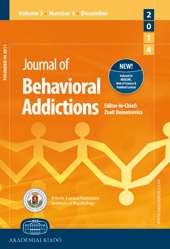Smartphone Addiction Proneness in Relation to Sleep and Morningness–Eveningness in German Adolescents
Smartphone Addiction Proneness in Relation to Sleep and Morningness–Eveningness in German Adolescents
Author(s): Christoph Randler, Lucia Wolfgang, Katharina Matt, Eda Demirhan, Şenol BeşolukSubject(s): Gender Studies, Cognitive Psychology, Behaviorism, Substance abuse and addiction, Social Informatics, ICT Information and Communications Technologies
Published by: Akadémiai Kiadó
Keywords: adolescents; circadian preference; morningness–eveningness; smartphone addiction proneness;
Summary/Abstract: Mobile phones are an important part of adolescents’ life. In this study, the relationships among smartphone addiction, age, gender, and chronotype of German adolescents were examined. Materials and methods: Two studies focused on two different measures of smartphone addiction. The Smartphone Addiction Proneness Scale (SAPS) was applied to 342 younger adolescents (13.39 ± 1.77; 176 boys, 165 girls, and 1 not indicated) in Study 1 and the Smartphone Addiction Scale was applied to 208 older adolescents (17.07 ± 4.28; 146 girls and 62 boys) in Study 2, both samples in southwest Germany. In addition, a demographic questionnaire and the Composite Scale of Morningness (CSM) and sleep measures were implemented. Results: The most remarkable result of this study was that morningness–eveningness (as measured by CSM scores) is an important predictor for smartphone addiction; even stronger than sleep duration. Evening oriented adolescents scored higher on both smartphone addiction scales. In addition, gender is an important predictor for smartphone addiction and girls are more prone to become addicted. In addition, while sleep duration on weekdays negatively predicted SAPS, age, sleep duration on weekends, and midpoint of sleep on weekdays and weekends did not predicted smartphone addiction in both scales. The analysis of covariance revealed statistically significant effects of the covariates gender and age in both studies, as well as the main effect of chronotype. According to the t-test results, girls had higher scores than boys in smartphone addiction. Conclusion: Evening types and girls are more prone to become smartphone addicted.
Journal: Journal of Behavioral Addictions
- Issue Year: 5/2016
- Issue No: 3
- Page Range: 465-473
- Page Count: 9
- Language: English

